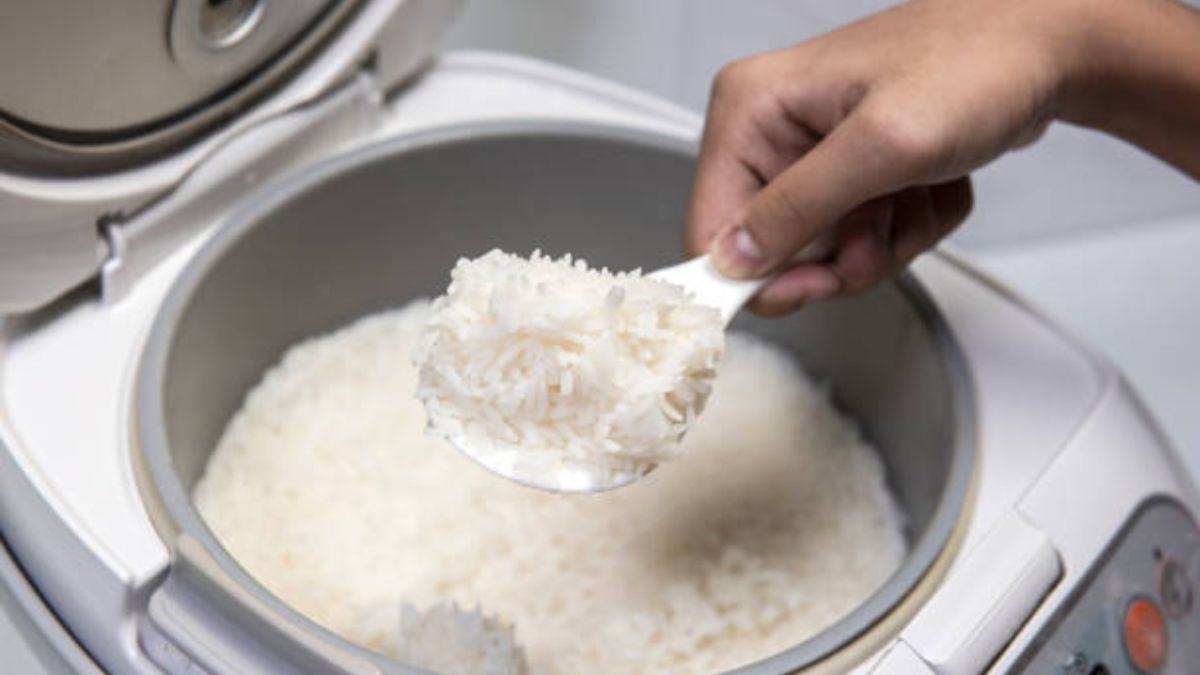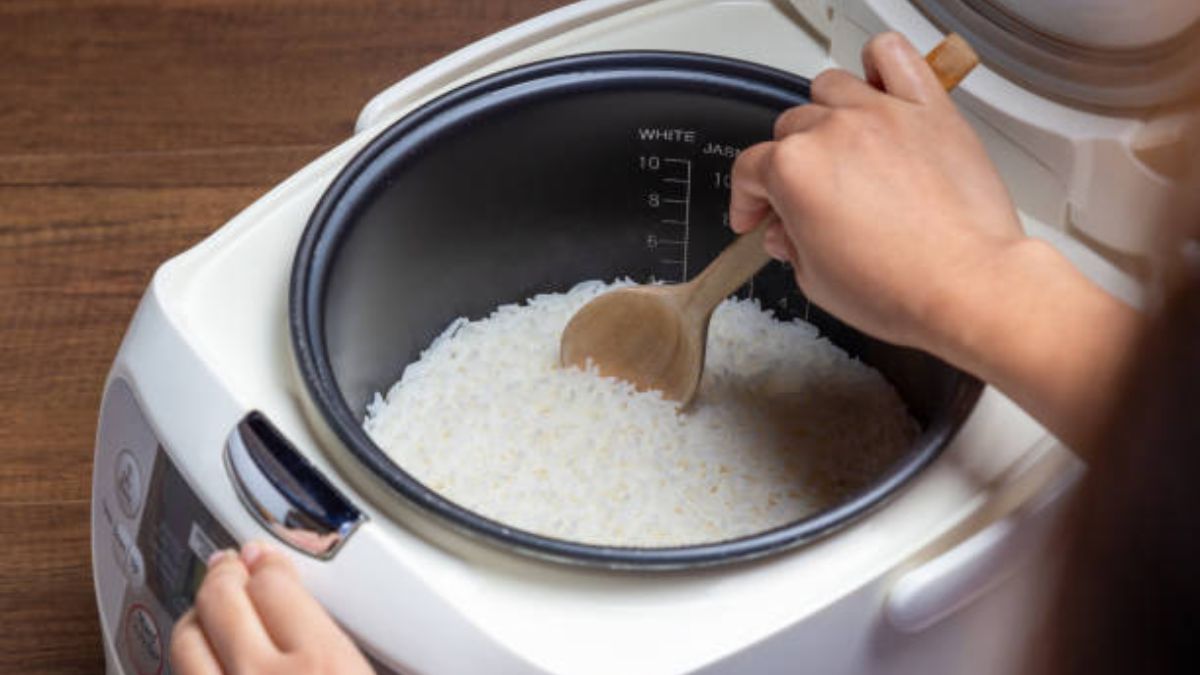Before cooking rice in a rice cooker, thoroughly wash the rice. This prevents rice grains from clinging to one another and supports good cleanliness. Brown or wild rice may need additional water, and a small amount of vegetable oil can aid in separating grains. Use one full cup of water for every cup of rice as a general rule; one cup of rice will provide about two cups of cooked rice. Rice can be made firmer or softer by adding or subtracting a small amount of water. For tougher rice, slightly lessen the water; for softer rice, slightly increase it.
How to Use your Rice Cooker?
A rice cooker can be a highly useful kitchen appliance if you cook (or consume) a lot of rice. It functions by rapidly bringing the liquid in the rice preparation to a boil. The air pressure over the liquid is reduced in the sealed environment of the rice cooker, causing the liquid to boil more quickly. A temperature sensor monitors the heat within the cooker, and when it starts to climb beyond 212 F (the boiling point of water), it signals that all of the liquid has been absorbed by the rice. The setting for the cooker will immediately change to warm. Normally, the entire operation lasts no more than 20 minutes.
It’s crucial to read and follow the directions with your rice cooker. The manufacturer of your rice cooker created these instructions. You will always obtain good outcomes if you do this. Not every rice has the same texture, and different textures yield varied results when cooked in the rice cooker. For instance, sticky rice (used in Asian cuisines) and short-grain rice like Arborio rice (used for risotto) are high in starch (also called amylopectin). Because of the highly branched nature of this starch and its propensity to stay together, rice will always be stickier and less fluffy than other types.
Choose the ideal rice for your diet based on your preferred finishing texture. Since long-grain rice contains more amylose, a long-straight starch molecule, it should be airy and not cling together. When the rice cooks, the molecule doesn’t become entangled with other molecules. Medium-grain rice has nearly equal levels of amylose and amylopectin. Thus, it should be fluffy with a somewhat stickier texture. Make sure to prepare the rice according to the directions on your type when following the rice cooker’s instructions. Additionally, you’ll need to measure the rice carefully; most rice cookers will have their measuring cups for this purpose.
Ingredients
- 1 to 2 cups rice (depending on the type)
- 2 cups water
- 1/2 teaspoon salt
Steps to Make it
- Gather the ingredients.
- For the sort of rice, you are preparing, according to the directions provided with your rice cooker. To make three cups of cooked rice or enough for six (1/2-cup) servings, combine one cup of rice with one and a half to two cups of liquid in most rice cookers.
- Start the rice cooker, and then allow it to cook as directed.
- Most rice cookers can maintain a warm temperature for hours without the rice burning. Check if your rice cooker has automatic warming or a particular warming setting. Enjoy alone or with your favorite dishes.
What is the Rice Cooker Size and Capacity?
Since not all shops or manufacturers adhere to the same description and advertising methods, it is important to identify whether their product refers to cooked or uncooked rice. Rice cooker size and capacity can be highly misleading. Rice cookers are generally marketed as 5-cup, 7-cup, 10-cup, and so on size models, referring to raw rice.
That often estimates how much-uncooked rice is required, both the minimum and maximum amounts (capacity). When choosing the best rice cooker for your needs, be aware that the ad may be completely inverted in wording. For instance, if you’re looking for a rice cooker for two people, a 5-cup model would be more suitable for regular cooking.
A larger model could not even be able to cook little quantities, like two to four cups. Because of this, capacity notations should be carefully considered before making a purchase. For a family, the 7-cup and higher capacity cookers might be better. There are minimums, but you can typically cook much less than that.
The finished volume (cooked rice) ought to be sufficient to serve your needs. A 5-cup or 7-cup rice cooker would suffice if you typically prepare 3 cups of raw rice for most meals. You can cook extra when you have dinner guests. However, choose a larger model if you enjoy having leftover rice and have space to store a larger cooker.
How to Store and Freeze Rice?
Rice can last up to five days in the refrigerator if stored correctly. If it feels dry to the touch before you reheat it, adding a small amount of water may sometimes be useful.
For up to four months, rice can also be frozen. Any leftovers should be stored in freezer-safe containers or zip-top bags.
How to Measure Rice for a Rice Cooker?
Except for specialized rice, cooking long grain white rice on a stovetop often involves adding a comparable amount plus a little extra water (for instance, 2 cups uncooked rice plus 2 1/2 cups water). This is extremely common, and you typically measure both components using the same measuring cup.
A simple rice cup measure is often included with rice cookers, and device manuals will offer cooking instructions based on these proportions. However, the measurement might get challenging if you use a rice cooker. A rice cup is measured at 180 milliliters, substantially less than the 240 milliliters that a conventional U.S. cup contains. So, the tiny cup that came with your cooker should be used. It lines up with the rice cooker’s water level line.
There is no issue if you measure rice and water in the smaller rice cup simultaneously or if you measure rice in the smaller rice cup and add water to the rice cooker pot up to the corresponding water line, which accounts for the smaller cup measurement. What you ought to do is that. However, if you use the smaller cup measure for the rice and a regular cup for the water, the proportions of the ingredients are off for the optimum cooking outcomes.
Remember that most rice cookers have handy measures written on the inner liner. A measuring cup is also present in several models. This is because a cup of raw rice has a slightly smaller general measure than an Imperial cup. Use the measuring cup with the rice cooker to measure the rice and the water, or follow the rice and water ratio specified by the manufacturer (for that type of rice) in the product handbook to avoid any confusion while measuring rice.
Can you Cook Things Other than Rice in a Rice Cooker?
Yes. Any grain, including quinoa, barley, farro, rice pilaf, risotto, polenta, or grits, can be prepared in a rice cooker. There may even be instructions for these ingredients in your rice cooker’s manual. In the rice cooker, you may easily steam vegetables and other meals.
Using a Rice Cooker to Steam Veggies and Meat
Vegetables steaming simultaneously as the rice improve the rice as it cooks. Most rice cookers include a steaming basket for this use, making them excellent electric steamers. Although not all rice cookers have it, many do, and this useful feature enables you to use this practical gadget for purposes other than just cooking rice. Your rice cooker will include a steaming tray or basket and a pre-set steam setting if it has a steam feature. Although the size of the rice cooker can undoubtedly determine the maximum size of steamed items, this is still a useful function. You can also steam meats or create a steamed dessert in addition to vegetables. It’s an excellent method for making meat soft for pulled pig or beef.
Put the cut and cleaned vegetables in the basket to activate the steam feature. Place those with hard peels, like pumpkin or squash, with the meat facing down. To preserve tastes while steaming meats or fish, place foil in the steaming basket or tray and cover. Additionally, this foil cover preserves the additional ingredients inside the meat. Veggies steam-cook in much less time than white rice, typically between 5 and 15 minutes, depending on the vegetables. White rice typically takes 35 minutes to cook in a rice cooker. Due to this, add the steam tray only after the white rice has finished cooking.
Vegetable steaming in a rice cooker will save space on your cooktop and result in wonderfully tender, fragrant sides. Additionally, it is useful for steam-cooking pumpkin pieces before peeling. After the pieces have cooled, remove the peel’s vegetable pulp for pumpkin pie filling. However, rice cooker steaming cycles are short, so even numerous cycles will steam quickly. For advice on steaming times, go to your product manual, but remember that even these can change depending on the toughness of the veggies and other factors like altitude and humidity levels. Larger veggies like squash or pumpkin must be prepared in multiple batches, with the parts being sliced to the right sizes to fit inside the basket.
Try steaming meats and vegetables as an experiment, and use a meat thermometer to check that the meat reaches a safe cooking temperature. Always wash your rice cooker thoroughly as directed by the manufacturer.
The water to rice ratio in the rice cooker’s bowl insert is based on scientific research. A heating element with built-in temperature control sensors is turned on when the cooking cycle is started. At 212°F, water begins to boil and transform into steam. The thermostat then shuts off, allowing the steam to cook the rice. One button on a rice cooker is all it takes to produce flawlessly fluffy white or brown rice in 20 to 60 minutes (though fancier models may have more buttons). Making it is simple, and the cooking pot can be used as a storage bowl if you have any leftovers.

